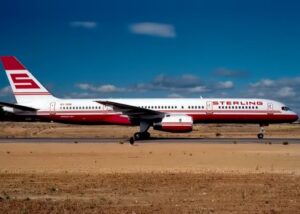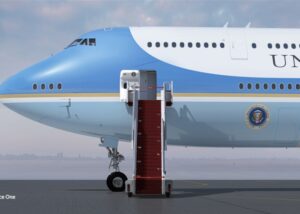Trump Force One
The B757-200 was built at the Boeing factory in Renton, WA, in 1991. The B757 remained in production until 2004. In the early 2000s, multinational airlines were opting for widebody jumbo jets like the Airbus A380 and Boeing 777. Airlines found it was cheaper to fly one jumbo jet to a destination rather than make three trips in a mid-sized plane like the B757. Hundreds of retired B757s could not be given away. Ironically, mid-sized airliners like the B757 have become popular again. Airbus just closed down their A380 production line.
Sterling Airways was the original owner. Sterling operated the plane as a scheduled passenger airline until 1993 when it filed for bankruptcy and lost the plane to the lender that funded the purchase. After Sterling’s bankruptcy, the lender leased it to a Mexican air carrier for a short period.

In early 1995, Vulcan Northwest Inc., an aircraft overhaul and refurbishing business, acquired the plane. Later in the year, when Vulcan completed the plane’s overhaul and refresh, the plane was sold to Paul Allen, a co-founder of Microsoft. Trump purchased the aircraft from Allen in 2011 for a reported $100 million.
The current Trump fleet includes the B757, three S76 helicopters, and a Cessna Citation 10 business jet. The S76s are located in New York, Florida, and Scotland.
After Trump Force One was purchased in 2011 from Paul Allen, Trump’s aviation director had the plane turned over to an MRO (maintenance, repair, and overhaul) and refurbishing shop. Trump and executives throughout his organisation used the plane until 2017, when Trump became President. The B757 was put in long-term storage at Stewart Airport (60 miles north of New York City) until 2021, when Trump finished his first term.
Now that Trump is back in the Oval Office, Trump Force One will return to storage.
Air Force One

Each of the current Air Force One aircraft is equipped with classified security and defence systems, including measures to protect onboard electronics against the electromagnetic pulse of a nuclear explosion. A telecommunications centre is located in the upper level, and in the lower level is a cargo hold with a self-contained baggage-handling system. The middle level contains accommodations for as many as 70 passengers in addition to the crew of 26. These accommodations include seating and work areas for media representatives, security staff, and other personnel; a combination conference-dining room; an in-flight pharmacy and emergency medical equipment; and two galleys in which as many as 100 servings per meal can be prepared. The presidential suite, located in the quiet forward area of the plane, contains an office, a bedroom, and a lavatory.
The two jets have a range of almost 8,000 miles (more than 12,000 km), but with in-flight refuelling they are capable of circling the globe. They are based at Andrews Air Force Base in Maryland, near Washington, D.C., and are assigned to the 89th Airlift Wing of the Air Force’s Air Mobility Command. They have served presidents, vice presidents (at which time they are known as Air Force Two), and other dignitaries under the administrations of George H.W. Bush, Bill Clinton, George W. Bush, and Barack Obama.
Comparison
- Purpose and Functionality: Air Force One is designed for presidential duties, emphasising security, communication, and the ability to operate during national emergencies. In contrast, Trump Force One serves as a personal luxury aircraft, focusing on comfort and opulence.
- Size and Capacity: Air Force One is significantly larger, accommodating more passengers and equipment, and includes specialised areas for operations. Trump Force One, while spacious, is configured for personal use with fewer passengers.
- Capabilities: Air Force One’s in-flight refuelling and advanced defensive systems ensure continuous operation during crises. Trump Force One lacks these features but offers superior speed and altitude capabilities for private travel.
Get in touch
© Sentinel Aviation. Company No. 09400896. Vat No. 221163359.
All rights reserved. Created by AJA Design.
